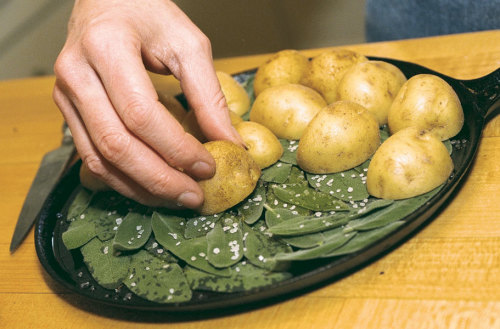
by Ruth Lively
June 1997
from issue #9
For years I grew sage and never used it. I loved its looks, but my palate cringed at its powerful, almost medicinal odor. I’m not a fan of poultry stuffing, and I’ve yet to tackle sausage-making, the only two uses I knew of for sage.
But one day I had a sage awakening. I added some to the potatoes I roast regularly, and it made a favorite recipe even better. Then I remembered a pot of white beans I’d eaten in Italy, redolent with sage and garlic and pepper. I began to look around for other ways to use sage. Pretty soon my one big plant wasn’t big enough.
With long cooking, sage’s assertive raw taste mellows to an understatement. It bumps up the flavor of starchy foods like potatoes, beans, squash, and stuffings, and of mild meats like pork, chicken, and veal. Briefly cooked, sage stands up well to more aggressive flavors like anchovies or garlic. In saltimbocca, a traditional Italian dish, the sage is pleasantly strong—very nice with the saltiness of the prosciutto and the sweetness of the wine.
Tuscan beans are wonderfully versatile. In cool weather they’re delicious hot, topped with a grilled sausage or a chop. A little extra cooking liquid turns them into a hearty soup. Cooked down and mashed, they’re the basis for a vegetable dip. In summer, I like to drain the beans and dress them while hot with a flavorful vinaigrette, then eat them at room temperature atop a bed of escarole or on bruschetta.
I harvest sage as I need it because it doesn’t keep long in the refrigerator. Any moisture on the leaves quickly causes them to turn black with decay. Sprigs will last a couple of days if stored in a dry, loosely closed plastic bag. You can substitute dried sage in the beans, but the potatoes and the saltimbocca depend on fresh sage. Fortunately, sage leaves withstand light frosts, so I usually can harvest into December in my Connecticut garden.

















Comments
Log in or create an account to post a comment.
Sign up Log in